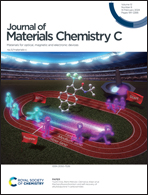Layered structure-induced quenching delay toward highly efficient and thermally stable red emission in Eu3+-activated borotellurate phosphors†
Abstract
The development of highly efficient rare earth-activated phosphor materials for solid-state lighting is restricted currently by concentration and temperature quenching behaviors. Herein, Eu3+-activated borotellurate Na2Y2TeO4(BO3)2 (NYTB) red-emitting phosphors are developed via a microwave-assisted method. The layered structure induces delayed concentration quenching (up to 50% Eu3+ activators), significantly contributing to highly efficient red emission with a luminescence efficiency of 83.7%. Meanwhile, the large energy barrier and sufficient structure rigidity of NYTB ensure low thermal quenching behavior. At 425 K, the red-emitting intensity only loses 6.3% of the original value at room temperature. Finally, a white light-emitting diode device is assembled with the NYTB:Eu3+, BaMgAl10O17:Eu2+, and (Ba,Sr)2SiO4:Eu2+ phosphors, exhibiting satisfactory lighting performance. This study not only deepens the insight of the layered structure-dependent concentration quenching delay, but also offers a thermally stable red phosphor candidate.



 Please wait while we load your content...
Please wait while we load your content...